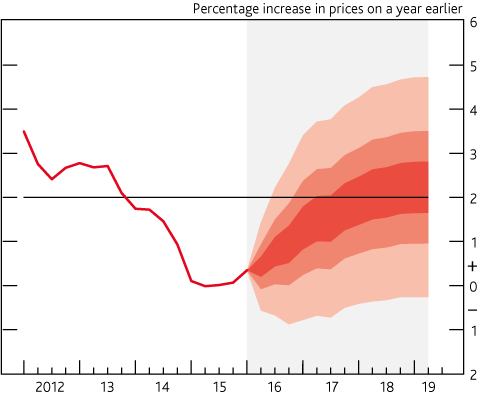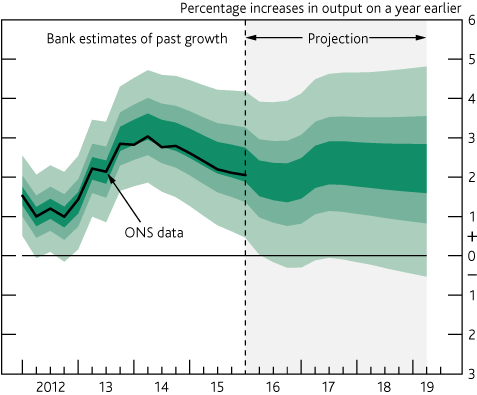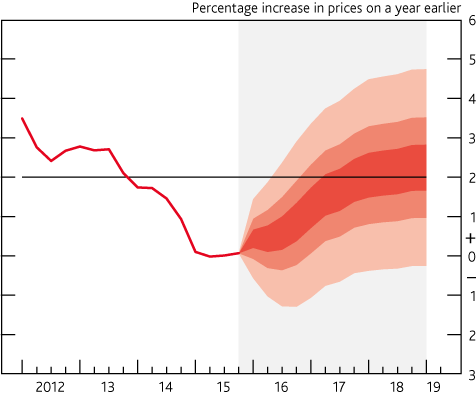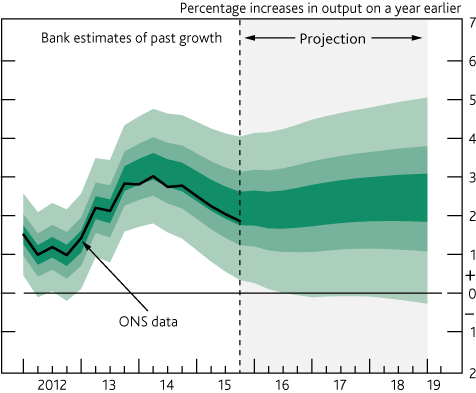Global economic and financial developments
Global activity growth was subdued in 2015 H2, as the pace of recovery in advanced economies softened alongside slower growth in emerging market economies. Inflation remains low globally, primarily due to past falls in commodity prices. After increased financial market volatility around the turn of the year, a number of factors, including policy announcements, appear to have contributed to a recovery in the prices of risky assets and should support the outlook for global activity. Sterling is 9% below its November peak, a material proportion of which appears to reflect the referendum on UK membership of the European Union.
Read more on global economic and financial developments
Demand and output
Quarterly GDP growth softened in 2016 Q1 and is projected to slow somewhat further in Q2 as recent increases in uncertainty weigh on activity. Exports fell over the second half of 2015, and the current account deficit widened to 7.0% of GDP. Private final domestic demand growth has remained resilient in the face of continued global and fiscal headwinds. Real income growth is likely to slow, however, as the boost from past falls in energy and food prices continues to fade.
Read more on demand and output
Supply and the labour market
Employment has grown at a strong pace in recent years and the unemployment rate has declined to around its pre-crisis average. Wage growth, however, has remained relatively weak. That is likely predominantly to reflect slow productivity growth but, more recently, a drag from the low level of headline inflation has probably also weighed on wage growth. It is possible, though, that a range of other factors, such as a fall in the equilibrium rate of unemployment and softer inflation expectations, have also dampened wage growth. As the factors weighing on wage growth dissipate, it is projected to pick up towards its pre-crisis average rate.
Read more on supply and the labour market
Costs and prices
CPI inflation rose to 0.5% in March, although it probably fell back to 0.3% in April. The low rate of inflation mainly reflects the effects of past falls in energy and food prices, but it also reflects the effects of the past appreciation of sterling on other imported goods and services prices, and subdued domestic cost growth. Inflation is projected to rise gently over the summer months as the effects of those external factors continue to fade, with the recent pickup in oil prices supporting that rise. Further ahead, domestic cost pressures are expected to pick up gradually. Inflation expectations are judged to remain broadly consistent with the MPC’s 2% target.
Prospects for inflation
CPI inflation has risen a little further, to 0.5%, but remains well below the 2% target. That shortfall primarily reflects a continuing, albeit temporary, effect from past falls in energy prices, along with a drag from the prices of food and other imported goods and services; domestic cost pressures also remain subdued. Four-quarter GDP growth has slowed from above-average rates in 2014, and is likely to have fallen back further in 2016 Q2 as uncertainty around the forthcoming referendum on UK membership of the European Union weighs on companies’ and households’ spending. Consistent with the MPC’s usual convention that government policy is followed, the projections in this Report are conditioned on an assumed continuation of EU membership, so that weakness in activity starts to unwind in the second half of the year. The MPC’s best collective judgement, conditioned on the path for Bank Rate currently implied by market interest rates, is that growth is likely to recover next year, such that spare capacity is eroded and, as the drag from external factors fades, rising domestic cost growth returns inflation to the 2% target by the middle of 2018.




